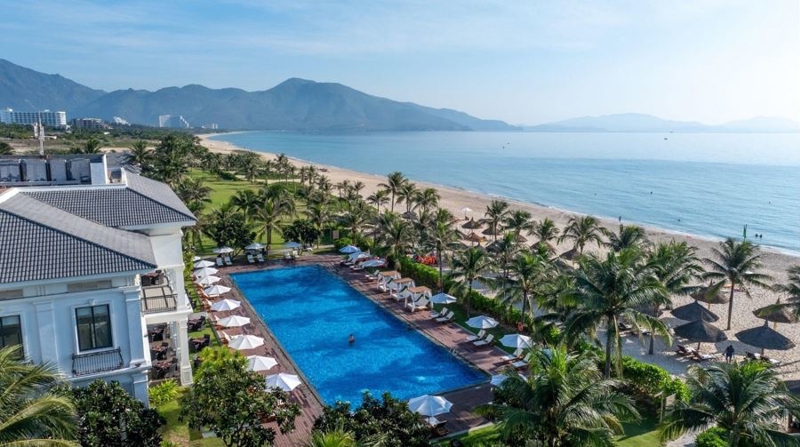Vietnam’s tourism and resort real estate market has faced continued headwinds since 2018, driven by both external and internal factors. Despite this, the market has been gradually regaining momentum thanks to resilient development strategies and a growing ability to adapt to shifting conditions.
To seize new revenue opportunities, resort real estate investors and hotel operators have been actively diversifying their approaches, with key trends including tapping into emerging destinations, accelerating digital adoption, enriching loyalty and guest engagement programs, optimizing investment costs, and reassessing management contracts.
Resurgence but challenges remain
According to Avison Young Vietnam, as of the end of 2024, the supply of 4-star and 5-star hotels nationwide was largely concentrated in coastal cities and provinces. Leading the way were central Da Nang city and south-central Khanh Hoa province, with 20,466 and 25,565 rooms, respectively, followed by the Mekong Delta’s Kien Giang province (now part of An Giang province), Quang Nam province (now part of Da Nang), northern Quang Ninh province, and Binh Thuan province (now part of the central highlands’ Lam Dong province).
After a subdued few years, 2024 saw a notable rebound in market activity. The average absorption rate, based on successful transactions, stood at around 57 per cent; double that of 2023. Mr. David Jackson, Principal and CEO of Avison Young in Vietnam and Cambodia, explained that tourism real estate, such as hotels, resorts, and condotels, is benefiting significantly from the resurgence of beach tourism, with Vietnam emerging as a bright spot on the global travel map.
Vietnam actually became the fastest-recovering tourism market in Southeast Asia in last year, outperforming Malaysia, Indonesia, Thailand, Singapore, and the Philippines. Total international arrivals reached around 98 per cent of pre-Covid levels, with the majority of visitors coming from South Korea, China, Taiwan, and Japan in Northeast Asia. There was also solid growth posted in arrivals from India, the US, Europe, and Southeast Asian countries. In the first quarter of 2025 alone, Vietnam welcomed over 6 million international visitors, a 134 per cent increase compared to the same period of 2019 and the country’s highest-ever quarterly figure.
According to The Outbox Company’s Vietnam Travel Landscape report for 2025, beach tourism was the most preferred type of travel among Vietnamese. At the same time, coastal destinations such as Ha Long Bay in Quang Ninh province, Da Nang, Nha Trang in Khanh Hoa province, and Phu Quoc Island in An Giang province also drew growing numbers of international visitors. In just the opening two months of this year, these destinations recorded year-on-year growth of between 14 and 27 per cent.
Mr. Mauro Gasparotti, Director of Savills Hotels Asia Pacific and in charge of Southeast Asia, highlighted a marked improvement in Vietnam’s tourism service quality. Once considered a destination for brief visits, Vietnam has successfully transformed into a place where travelers return for longer, more meaningful stays. Tourists are increasingly drawn back to destinations with distinctive local identities, enhanced by improved infrastructure, amenities, and direct flight connections. “This demonstrates Vietnam’s growing competitiveness on the global tourism stage,” he commented.
Looking ahead, he sees tremendous potential for coastal tourism real estate, especially as the Vietnamese Government has a target of welcoming 50 million international visitors by 2030 while continuing to diversify source markets.
Notably, the government has officially prioritized beach tourism development in the Strategy for the Sustainable Development of Vietnam’s Marine Economy by 2030 with a Vision to 2045. This strategy focuses on three main pillars: investing in tourism infrastructure; encouraging participation from various economic sectors in developing high-quality coastal resorts; and building out and diversifying beach tourism offerings.
However, challenges remain. “Even with a coastal spatial plan and legal framework in place, complexities around land use rights, lease durations, investment licensing, and environmental protection continue to be bottlenecks,” Mr. Gasparotti noted. He also pointed out that underdeveloped transport infrastructure and public amenities are still limiting both accessibility and the overall tourist experience, particularly during peak seasons or adverse weather conditions.
Global brands, local moves
According to Mr. Jackson, the number of international hotel brands operating in Vietnam has doubled over the past three decades, especially since 2000. Major players such as Hilton, the Radisson Hotel Group (RHG), Accor, and IHG continue to expand their footprint around the country by diversifying their service segments and elevating quality standards.
For domestic investors, partnering with international hotel operators has become a key strategy to upgrade service quality to global benchmarks and enhance their appeal among high-income travelers and international guests. This synergy has led to a noticeable increase in strategic collaborations between developers and operators in recent years.
As competition grows and the tourism sector experiences rapid transformation in the post-pandemic era, hospitality real estate investors and hotel operators are shifting their approach to capture new revenue streams and improve operational efficiency.
One significant trend is the growing focus on emerging destinations. Provinces such as Ninh Binh, Gia Lai, Quang Ngai, and Dak Lak saw impressive growth in visitor numbers from 2022 to 2024. They also boast long-term tourism potential thanks to their abundant land reserves, relatively undeveloped commercial tourism landscape, unique ecosystems, including national parks and biosphere reserves, and rich local cultures. Early entry into these markets would provide investors with a strategic advantage and long-term brand positioning.
However, sustainable development is crucial. Developers must carefully assess the environmental, economic, and social impacts of their projects, ensure alignment with master plans that balance development and conservation, and conduct thorough market research with a long-term view of supply-demand dynamics and target customer segments.
At the same time, both developers and hotel operators are ramping up efforts in digital transformation and guest engagement. They are upgrading facilities, expanding service offerings, building destination ecosystems, and personalizing experiences through digital tools. Loyalty programs are also being prioritized to retain guests and build brand affinity, especially among Millennials and Gen Z travelers, who are experience-driven and adventurous but highly cost-conscious.
Given the high capital and maintenance costs of coastal hospitality projects, often due to environmental compliance and exposure to severe weather, investors and operators are increasingly focused on cost optimization. This includes smart design choices, the use of sustainable materials, and efficient operational systems. Hotel management contracts are also being renegotiated to ensure a fairer balance of benefits and responsibilities between property owners and hotel operators.
Despite these improvements, Mr. Jackson emphasized that even the most attractive investment opportunities will not reach their full potential without strong destination marketing efforts. He stressed the need to promote cultural heritage, strengthen tourism campaigns in key source markets, and develop public-private partnerships to diversify tourism offerings.
Mr. Gasparotti, meanwhile, highlighted that Vietnam has enormous natural advantages, from its long and beautiful coastline to its highlands and mountainous regions. While the potential to attract tourists is clear, infrastructure and product quality remain decisive factors. Without improvements in these areas, even well-located projects may fall short in terms of revenue performance and competitiveness.
He also noted that now is a favorable time to explore opportunities in hospitality real estate, as the regulatory framework has become more transparent. However, success will depend on choosing the right partners, selecting well-positioned projects, and developing concrete business models that can support sustainable, long-term growth.









 Google translate
Google translate